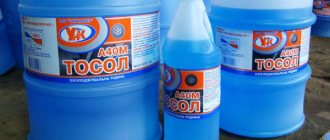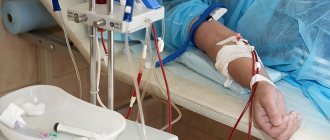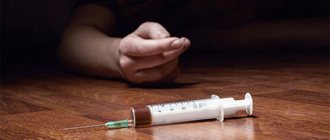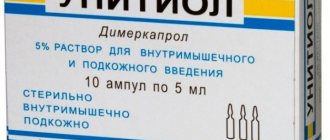Today there are a large number of industrial factories that are located near residential areas. Some people work in such factories and are exposed to hazardous chemicals every day. Ammonia (hydrogen nitride) has a particularly negative effect on the human body, so you need to know about the scope of use, features and possible consequences of poisoning with a chemical substance. If simple safety rules are not followed, you can easily become poisoned by toxic ammonia.
Features of hydrogen nitride and its scope of use
Ammonia is a gas that has no color, but has a pronounced suffocating odor. It is impossible to confuse this chemical substance. Hydrogen nitride is used in liquid form as part of household solvents. Its concentration in household chemicals reaches 25-30%. The chemical compound is most often found in solution form in solvents and cleaners for industrial use.
Gas in its pure form is not used, as it has a negative toxic effect on human health. This factor does not prevent people from using hydrogen nitride for the manufacture of finishing and paint materials. In traditional medicine, ammonia is known as ten percent ammonia. The solution is used to bring a person to consciousness during a fainting state or to stimulate vomiting in case of poisoning and other pathologies. For the treatment of neurology and myositis in medicine, agents are often used in the form of liniment, which includes ammonia, and therefore ammonia.
Content:
- Features of hydrogen nitride and its scope of use
- How can a person become poisoned by ammonia?
- Symptoms of chemical poisoning
- First emergency aid for ammonia poisoning
- What to do after poisoning?
- About the consequences
- Preventive measures
In addition, the concentrated solution is used to fertilize land. The gas is used to make explosives, and ammonia is also needed to make freezers and refrigerators. In domestic conditions, hydrogen nitride is used to clean surfaces or fabrics from paint, coffee, varnish, oil and grease stains, mold and milk. Cleaners often use a concentrated solution to wash tiles, floors and glass.
Although ordinary people rarely encounter toxic fumes in their daily lives, they still need to be very careful with products that contain ammonia. Correct and timely provision of first aid for hydrogen nitride poisoning can save a person’s life and minimize possible complications.
Consequences and complications
Severe hydrogen nitride poisoning is fraught with the development of complications such as pulmonary edema, acute heart failure, acute toxic encephalopathy, acute failure of liver and kidney function. These conditions require special inpatient treatment in the intensive care unit or intensive care unit.
Long-term consequences of ammonia poisoning also develop after severe intoxication . They are often manifested by a disorder of brain function: a decrease in memory, thinking abilities, the formation of a convulsive syndrome, and mental disorders (depression, hallucinatory syndrome) are also possible.
There is a high probability of developing vascular dystonia due to decreased tone of the arterial walls . Characterized by hypotension with attacks of dizziness and headaches. From the respiratory tract, chronic obstructive bronchitis, pneumonia and even asthma can form.
Eye burns from ammonia vapor can lead to the development of inflammation and clouding of the membranes of the eye, and decreased vision.
How can a person become poisoned by ammonia?
The toxic compound in the air should not exceed 20 milligrams per 1 cubic meter. If a person stays in a room with a high concentration of a substance, there is a high risk of poisoning from toxic fumes. Ammonia emissions can form in the air due to accidents at industrial plants and stations. You can get gas poisoning when working in a treatment pit or sewer if you do not use individual sealed protective equipment.
When the chemical enters the blood and inner layers of the skin, hydrogen nitride affects the blood vessels, causing them to dilate and the pressure in the arteries to drop. Due to a sharp decrease in blood pressure, collapse may develop. The compound has an irritating effect on the mucous membrane of the organ of vision, nose, pharynx and other organs, resulting in a chemical burn.
Ammonia is harmful to health
After all, this gas is a caustic alkali, which means it can dissolve in the moisture released by these surfaces. As a result, with excessively long contact with air saturated with vapors, reflexive breath holding, as well as chemical burns of the respiratory tract and eyes, can occur. Of course, such serious consequences for human health are possible only under conditions of significant concentrations (for example, after an accident at industrial enterprises using this substance, etc.).
The liquid causes severe skin burns, so it is usually transported in steel cylinders (painted yellow, with the inscription “Ammonia” in black), railway and road tanks, by water - in special tankers, and also transported through pipelines. Ammonia is very soluble in water: 1 volume of water dissolves about 700 volumes of ammonia at room temperature. An aqueous solution of ammonia is called ammonia or ammonia water.
Symptoms of chemical poisoning
There are three main ways gas enters the human body: the first is through the eyes, the second is through the skin, and the third is through the respiratory tract. The gaseous substance has high destructive activity, so the first signs of poisoning appear instantly. Even if a person breathes toxic fumes for a short period of time, there is a risk of poisoning.
The first symptoms of ammonia poisoning include:
- mucous discharge from the nose;
- hoarseness;
- hyperemia, i.e. redness - the mucous membranes are filled with blood;
- tears appearing in the eyes;
- increased salivation;
- sore and sore throat;
- severe dry cough;
- feeling of asphyxia.
Also often encountered: headache; nausea turning into vomiting; abdominal pain; feeling of constriction in the chest; heartburn. If the ammonia solution was very concentrated, a person develops serious symptoms in the form of damage to the organ of vision (blindness is possible due to eye burns), skin (painful plaques or crusts form due to a chemical burn), upper respiratory tract (swelling of the lungs may occur , disturbance of the respiratory system and blood circulation, pneumonia is possible).
Ammonia poisoning threatens internal organs and systems. If internal organs are burned, the victim may die; first aid provided will be useless. It is possible to predict the degree of damage to the lungs, eyes, and nasopharynx only by knowing the concentration of the substance and the duration of inhalation of the gas.
How does ammonia affect human health?
For its accumulation, reducing conditions are required. Hydrogen sulfide can enter watercourses with wastewater from chemical, food, pulp production, and city sewerage. Hydrogen sulfide is not only toxic, it has a strong unpleasant odor (the smell of rotten eggs), which sharply worsens the organoleptic properties of water, making it unsuitable for drinking water supply.
Significant volumes of hydrogen sulfide are released to the surface in volcanic areas, but for our area this route is not significant. In our surface and underground watercourses, hydrogen sulfide is released during the decomposition of organic compounds. There can be especially a lot of hydrogen sulfide in the bottom layers of water or in underground waters - in conditions of oxygen deficiency. In the presence of oxygen, hydrogen sulfide quickly oxidizes.
We recommend reading: Where is it better to change your passport at MFC or UFMS
First emergency aid for ammonia poisoning
To prevent the development of serious side effects and consequences of poisoning with a toxic compound, it is necessary to provide first aid to the victim in a timely manner. The first step is to report ammonia poisoning to an ambulance station and call a team of paramedics. Next, you need to take the poisoned person out into the fresh air.
If possible, you should rinse the mouth and nasal cavity with water with the addition of citric acid. To relieve the first symptoms, it is recommended to drip the medicinal solution “Dikain” into the eyes and wear glasses to protect from sun rays. If damage to the upper digestive tract is observed, it is necessary to perform gastric lavage using a weak saline solution.
If the mucous membranes and epidermis are damaged, you need to wash the injured areas with warm running water and apply a sterile bandage or wrap them with an elastic bandage.
If there is an unpleasant toxic odor in the room, the first step is to protect the upper respiratory tract. To do this, apply a bandage of gauze to your nose and lips, previously soaked in a solution of table vinegar or citric acid. In order to alleviate the condition of the victim, he should inhale the vapors through a special inhalation device.
If the victim stops breathing and loses consciousness, he needs to be given artificial ventilation using mouth-to-mouth or mouth-to-nose techniques. It is advisable to do this manipulation without interruption, waiting for the arrival of medical workers who will begin providing qualified medical care.
First aid
First aid for ammonia poisoning begins with calling an emergency medical team. The patient's contact with ammonia must be stopped as soon as possible.
If possible, you need to take it out into the fresh air. If poisoning occurs as a result of an accident at an enterprise or an ammonia leak, then the person must be removed from the affected area.
Before the doctors arrive, try to provide all possible assistance.
It is worth remembering that ammonia vapor is very light and rises. Accordingly, elevated areas with ammonia emissions should be avoided.
In addition, a patient with poisoning must:
- Rinsing the mouth with weak solutions of acids used in food. A solution of citric acid or vinegar diluted in water may be suitable.
- If there are chemical burns on the skin, they should be washed with clean water and then covered with a bandage. As a bandage, you can use any clean, but most importantly, natural fabric. Synthetic materials may react with ammonium.
- If the patient is vomiting, then, before the ambulance arrives, you can rinse the stomach using saline solution.
- Damage to the visual analyzer requires the use of eye drops, if available. If there are no drops, then you need to cover your eyes with a damp piece of cloth.
Providing first aid for ammonia poisoning should be immediate, since the patient, due to damage to the eyes and respiratory system, is not able to seek help himself.
What to do after poisoning?
After poisoning, the person is hospitalized and is in the toxicology department. Specialists monitor the patient’s well-being for 24 hours after poisoning. The patient is prescribed bed rest, even if there are no symptoms. If symptoms are still observed, symptomatic therapy is carried out.
If the patient has pronounced laryngospasm, a tracheostomy is performed. Comprehensive treatment of skin burns is also carried out, with much attention paid to the cornea. For preventive purposes, antibiotics and other medications are prescribed that prevent the development of pneumonia and other diseases of internal organs.
Cosmetics and essential oils
etc.) . The corpses of fallen, roadside and euthanized pets - the San Francisco Chronicle wrote about this, feed manufacturers angrily denied this fact, and the American Veterinary Medical Association confirmed it. Expired meat products from supermarkets. Since most companies producing feed are branches of food industry giants, by processing by-products of the main production in this way, they practically achieve zero waste.
We recommend reading: Time of silence in Tatarstan
Ammonia is the end product of nitrogen metabolism in the body of humans and animals. It is formed during the metabolism of proteins, amino acids and other nitrogenous compounds. It is highly toxic to the body, so most of the ammonia during the ornithine cycle is converted by the liver into a more harmless and less toxic compound - carbamide (urea). The urea is then excreted by the kidneys, and some of the urea may be converted by the liver or kidneys back to ammonia.
About the consequences
Not only the symptoms of ammonia poisoning are dangerous, but also its consequences. The most common include: dysfunction of the nervous system (nervous tic, loss of balance, dizziness, decreased sensitivity, loss of smell, disorientation, decreased intellectual potential, tremor, memory loss); blindness (partial or complete loss of vision is possible); hearing loss (there is a risk of complete deafness and hearing loss).
Best materials of the month
- Why you can't go on a diet on your own
- 21 tips on how to avoid buying stale food
- How to keep vegetables and fruits fresh: simple tricks
- How to curb your sweet cravings: 7 unexpected products
- Scientists say youth can be extended
To avoid such serious consequences, you need to follow simple safety rules. One person's negligence can be fatal to the health of others.
Ammonia poisoning when ingested
During the breathing process, ammonia hydroxide vapors enter the body, and the substance actively begins to interact with the trigeminal nerve, while reflexively stimulating the respiratory center. A concentrated solution can cause colliquation (dissolution, softening) of microbial cell proteins.
If liquid ammonia gets on human skin, it immediately causes severe burns. Ammonia poisoning: why does it happen?
The non-bonding two-electron cloud is strictly oriented in space, so the ammonia molecule has high polarity, which leads to its good solubility in water. In liquid ammonia, the molecules are connected to each other by hydrogen bonds.
If there are symptoms of damage to the skin, rinse the surface with plenty of clean water and apply a bandage. You can do inhalations using a device such as a nebulizer, it helps to alleviate the patient’s condition.
Pharmacodynamics and pharmacokinetics
If you want to find out how to solve your particular problem, please use the online consultant form on the right or call the numbers provided on the website. It's fast and free!
- Why is ammonia dangerous?
- How does ammonia affect human health?
- Chemist's Handbook 21
- Ammonia: why it is dangerous and what to do in case of poisoning
- Ammonia and its effects on the human body
- “Ammonia is very dangerous because it spreads in the wind.”
If poisoning occurs using a highly concentrated solution, the victim may experience a burn to the upper respiratory tract, which subsequently leads to swelling and pneumonia of the lungs. Ammonia monohydrate also works well when removing cockroaches. To do this, add a little product to a bucket of water when washing the floor, furniture and walls (about 1 tsp per liter of water). The pungent smell will drive away uninvited guests, especially if the procedure is done once a week. To prevent your outdoor recreation from being spoiled by mosquito and midge bites, you need to take an ammonia solution with you and spray it around.
Chemically harmful substances and their effects on the human body
- chest pain;
- clouding of consciousness;
- violation of urination (delay);
- swelling of the vocal cords.
If these symptoms appear, immediately call an ambulance and rescuers. If the symptoms are absent or mild, and a subtle odor is present, we advise you to contact an independent environmental expert.
In what areas is ammonia poisoning most common? Ammonia is used everywhere. Particular care must be taken where this product accumulates in large quantities or where direct contact with it is possible.
was obtained by the English chemist and philosopher Joseph Priestley in 1774.
Haber and Carl Bosch, who received Nobel Prizes for their research.
- one of the most important products of the chemical industry. Most of the ammonia produced in industry is used for the preparation of nitric acid, nitrogen fertilizers, and dyes.
Ammonia is also used to produce explosives.
Aqueous solutions of ammonia are widely used.
As a weak volatile base, it is used in chemical laboratories and industries.
Baking soda is produced using ammonia. In medicine, a 10% aqueous solution of ammonia is known as ammonia. The pungent odor of ammonia irritates specific receptors of the nasal mucosa and promotes stimulation of the respiratory and vasomotor centers, therefore, in case of fainting or alcohol poisoning, the victim is allowed to inhale vapors of ammonia.
When soldering metals, ammonium chloride is used - ammonia - NH4Сl. At high temperatures, ammonia decomposes to form ammonia, which cleans the surfaces of the soldering iron and the product being soldered from metal oxides.
Ammonia is used to cool the International Space Station's (ISS) power ducts, which provide electricity to the ISS.
A mixture of ammonia and air is explosive.
Ammonia burns in the presence of a constant source of fire. Containers may explode when heated. Ammonia gas is a toxic compound.
When its concentration in the air of the working area is about 350 mg/m3.
Causes severe coughing, suffocation, and with a high concentration of vapors - agitation, delirium.
First aid: rinse eyes and face with water, put on a gas mask or a cotton-gauze bandage moistened with a 5% solution of citric acid, rinse exposed skin with plenty of water, immediately leave the source of infection.
If ammonia gets into the stomach, drink several glasses of warm water with the addition of one teaspoon of table vinegar per glass of water and induce vomiting. Personal protection: insulating and filtering gas masks of grades M, KD, RPG-67KD respirator, in their absence - a cotton-gauze bandage moistened with a 5% solution of citric acid, a protective suit, rubber boots, gloves. The affected area must be isolated.
Enter the accident area only in full protective clothing.
In case of fire: remove from the fire area if it does not pose a danger and allow it to burn out. Do not get close to burning containers.
Cool containers with water from a maximum distance. Extinguish with sprayed water and air-mechanical foam from a maximum distance.
The material was prepared based on information from RIA Novosti and open sources
Poisoning at home is also possible if the container with ammonia is not tightly closed, this gas enters the air in the room.
You can also get intoxicated during inhalation, when you sniff a cotton swab with ammonia for more than 3-5 seconds to bring you to your senses and relieve fainting. As a result, the effect is the opposite. Sometimes ammonia is added to water for alkaline inhalations for bronchitis.
The maximum permissible concentration of ammonia in the air of the working area is 20 mg/m3.
m. Ammonia is dangerous if inhaled.
Acute ammonia poisoning affects the eyes and respiratory tract, and can be fatal at high concentrations.
Causes severe coughing, suffocation, and with a high concentration of vapors - agitation, delirium. Upon contact with skin - burning pain, swelling, burn with blisters.
Ammonia and its effects on the human body Ammonia translated from Greek (hals ammoniakos) means ammonium salt.
Ammonia is a colorless gas with a pungent odor, melting point - 80 ° C, boiling point - 36 ° C, soluble in water, alcohol and a number of other organic solvents.
Synthesized from nitrogen and hydrogen.
We suggest you read: Is a privatized apartment considered joint property?
In nature, it is formed during the decomposition of nitrogen-containing organic compounds. Pure ammonia was obtained by the English chemist and philosopher Joseph Priestley in 1774.












